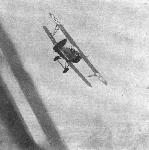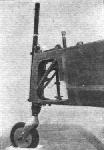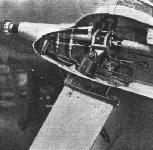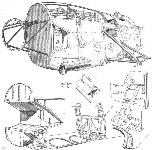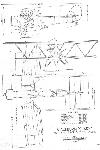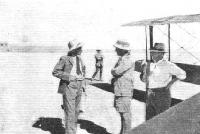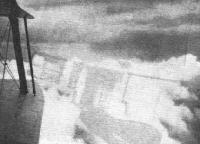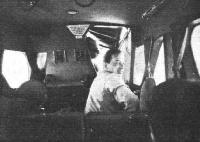Фотографии
-
Arrangement of the air-driven electric generator in the Fiat CR 32 single-seater fighter.
Самолёты на фотографии: FIAT CR.30 / CR.32 Chirri - Италия - 1932
-
ON DURBAN AERODROME: Five of the South African Airways fleet, including the three new Ju 52's which recently flown out from Dessau.
Самолёты на фотографии: Junkers Ju.52/3m - Германия - 1931
-
Engine nacelle and retractile undercarriage of the Potez 540 bomber. Note the nose gun turret.
Самолёты на фотографии: Potez Potez 54 - Франция - 1933
-
ANTECEDENT: In our recent description of the Short-Mayo "composite aeroplane" scheme we referred to a War-time experiment on the same lines, carried out at Felixstowe. This photograph, reproduced from The Wing (journal of the Felixstowe R.A.F. Station) of November, 1918, shows the machines concerned; the parent aircraft was the original Porte "Baby" flying boat and it carried a Bristol "Bullet." The late Lt.-Col. Porte (in white muffler) is seen walking under the tail plane; the pilot of the "Bullet" was the late Flt. Lt. Day. The copy of The Wing from which this was taken was kindly sent by Mr. Charles A. Rippon, who is Hon. Chairman of the Northern Heights M.F.C. and a member of the Felixstowe Old Comrades Association.
Самолёты на фотографии: Bristol Scout - Великобритания - 1914Porte Baby - Великобритания - 1916
-
Регистрационный номер: K3020 FOR HIGH ALTITUDES: The Hawker "Hart" fitted with the fully supercharged 9-cyl. Bristol "Pegasus" IV, rated at 660 h.p. at 11,500 ft.
Самолёты на фотографии: Hawker Hart - Великобритания - 1928
-
ONE GOOD TURN... A "Hart," with the chief photographer of "Flight" as passenger, keeps hard on the tail of a similar machine with "Pegasus" engine, built for Sweden and flown by Flt. Lt. P. W. S. Bulman.
Самолёты на фотографии: Hawker Hart - Великобритания - 1928
-
IN "APPROACH" POSITION: The split flaps on the "Hawk Major"; notice how the central flap opens in the reverse direction.
Самолёты на фотографии: Miles Hawk / M.2 - Великобритания - 1932
-
Messier retractile undercarriage on the big Bloch 211.
Самолёты на фотографии: Bloch MB.210 Verdun - Франция - 1934
-
Самолёты на фотографии: Blackburn Shark / B-6 - Великобритания - 1933
-
The rear portion of the fuselage without its outer plating.
Самолёты на фотографии: Blackburn Shark / B-6 - Великобритания - 1933
-
Fuselage construction at the tail.
Самолёты на фотографии: Blackburn Shark / B-6 - Великобритания - 1933
-
NOTEWORTHY: A three-quarter front view of the "Shark," which shows clearly the strut bracing of the wings.
Самолёты на фотографии: Blackburn Shark / B-6 - Великобритания - 1933
-
A close-up of the bottom front spar fitting, showing the hydraulically operated pin. The lever is half hidden behind the undercarriage leg.
Самолёты на фотографии: Blackburn Shark / B-6 - Великобритания - 1933
-
The root end of a lower outer plane. The spar is one of Boulton Paul's drawn sections of wrap-jointed steel tube.
Самолёты на фотографии: Blackburn Shark / B-6 - Великобритания - 1933
-
These drawings show the monocoque construction of the centre and front portions of the fuselage. At the bottom, on the left, are the manholes through which the fuel tanks are offered up into the fuselage; the holes are then closed with water-tight doors.
Самолёты на фотографии: Blackburn Shark / B-6 - Великобритания - 1933
-
A bottom wing centre-section. On the right is the rear spar fitting, which is also a catapult connection.
Самолёты на фотографии: Blackburn Shark / B-6 - Великобритания - 1933
-
Blackburn "Shark" Armstrong Siddeley "Tiger" Engine
Самолёты на фотографии: Blackburn Shark / B-6 - Великобритания - 1933
-
How the "Jumo" 5 engine (vertically opposed compression-ignition two-stroke, with six cylinders and twelve pistons) is mounted in the Junkers Ju 52
Самолёты на фотографии: Junkers Ju.52/3mW (See) - Германия - 1933
-
Регистрационный номер: PH-AJU RECEPTION: When the K.L.M. "Douglas" returned to Schipol aerodrome, Amsterdam, after the Melbourne Race, 80,000 people were present to see the famous machine and its crew. The line of mounted police in the background adds a picturesque touch.
Самолёты на фотографии: Douglas DC-1 / DC-2 / C-32 / C-39 - США - 1933
-
This "skeleton" drawing illustrates the essential features of the head of the Kay Gyroplane. The small plan on the left shows how the rotation of the "Z" crank G imparts a lateral motion to the whole of the head, while the change of incidence for the blade is produced in the same manner with the "Z" cranks G'
Самолёты на фотографии: Kay Gyroplane - Великобритания - 1932
-
Kay Gyroplane Pobjoy "R" Engine
Самолёты на фотографии: Kay Gyroplane - Великобритания - 1932
-
A SPORTS MODEL: The fascinating little Italian Magni "Vale" single-seater, with 130 h.p. Farina engine, which attracted much attention at the recent Paris Show, owing to its beautiful finish and businesslike appearance.
Самолёты на фотографии: Magni PM.3 Vale - Италия - 1934
-
A castor nose wheel allows the fullest use to be made of the wheel brakes of the Hammond Model Y. This photograph is of a model.
Самолёты на фотографии: Stearman-Hammond Y-1 - США - 1936
-
Регистрационный номер: G-ACOR "OR" ready to leave Baghdad.
Самолёты на фотографии: De Havilland Dragon / D.H.84 - Великобритания - 1932
-
Taken while refuelling at Rutbah. Left to right are Mr. Jerry Nairn, of Nairn Transport, Mr. Graham Mackinnon (owner of the "Dragon") and a friend of all pilots, who has the isolated job of wireless operator at the fort.
Самолёты на фотографии: De Havilland Dragon / D.H.84 - Великобритания - 1932
-
J. K. Morton, the "Dragon's" pilot, satisfying the Egyptian customs officials at Mersa Matruh.
Самолёты на фотографии: De Havilland Dragon / D.H.84 - Великобритания - 1932
-
Самолёты на фотографии: De Havilland Dragon / D.H.84 - Великобритания - 1932
-
Clouds - an impression from the "Dragon's" cabin windows.
Самолёты на фотографии: De Havilland Dragon / D.H.84 - Великобритания - 1932
-
The pilot, Mr. J. K. Morton, looking back in the cabin towards Mr. Graham Mackinnon.
Самолёты на фотографии: De Havilland Dragon / D.H.84 - Великобритания - 1932
-
Le Bourget from the air; an Imperial Airways H.P.42 can be seen on the tarmac.
Самолёты на фотографии: Handley Page H.P.42 / H.P.45 - Великобритания - 1930
-
Imperial Airways H.P. 42's, too large for the Heliopolis aerodrome hangars at Cairo, produce "Mother and little pigs" effect.
Самолёты на фотографии: Handley Page H.P.42 / H.P.45 - Великобритания - 1930
-
Регистрационный номер: I-SIAI, OO-AGL ITALIAN EQUIPMENT FOR S.A.B.E.N.A. Three Savoia Marchetti S.73 eighteen-passenger monoplanes of the type shown here, fitted with 600 h.p. Gnome Rhone K.g engines, will soon augment S.A.B.E.N.A.'s fleet. The machines' cruising speed is 167 m.p.h. and the maximum speed 202 m.p.h.
Самолёты на фотографии: Savoia-Marchetti / SIAI S.73 - Италия - 1934
-
Регистрационный номер: G-ACSS, K5084 Самолёты на фотографии: De Havilland Comet / D.H.88 - Великобритания - 1934
-
Регистрационный номер: G-ACSR, F-ANPY MAILS TO THE CONGO: The modified (and renamed) "Comet" ready for Mr. Ken Waller and M. Franchomme to carry the Christmas mails to the Congo. With the rear tank removed and with a mail compartment and a smaller tank in the nose, the machine still has a safe range of 2,000 miles carrying 200-250 lbs. of mail matter. The "Reine Astrid" left Brussels last Thursday.
Самолёты на фотографии: De Havilland Comet / D.H.88 - Великобритания - 1934
-
SLIPPERS : The "Envoy's" equipment.
Самолёты на фотографии: Airspeed Envoy / AS.6 - Великобритания - 1934
-
Регистрационный номер: VT-AFM VICEREGAL: The Star of India, an Avro 642 (four "Lynx IVc") for the Viceroy of India. It travels over 600 miles at 130 m.p.h., with six passengers and four crew. The seating and interior decoration are particularly luxurious.
Самолёты на фотографии: Avro Type 642 - Великобритания - 1933
-
AMERICA'S NEWEST: The Martin flying boat ordered for a proposed Trans-Pacific service of Pan American Airways. Note the sponsons for lateral stability on the water, and the cowling and placing of the 800 h.p. two-row radial engines.
Самолёты на фотографии: Martin China Clipper / Type 130 - США - 1934
-
TWO-SEATER FIRE POWER - SINGLE-SEATER SPEED: The Consolidated P. 30 two-seater "pursuit" or fighter monoplane believed to be the type ordered by the U.S. Army Air Corps as stated on this page. Fitted with a twelve cylinder Curtiss "Conqueror" of 650 h.p., equipped with an exhaust-driven supercharger, the top speed is about 250 m.p.h. - faster than most single seaters.
Самолёты на фотографии: Consolidated P-25 / P-30 / PB-2 - США - 1932
-
Регистрационный номер: D-IPUS The Fieseler four-seater built for the Challenge de Tourisme; large Fowler flaps are an interesting feature.
Самолёты на фотографии: Fieseler Fi.97 - Германия - 1934
-
Регистрационный номер: G-ADCS [3] A three-quarter front view of the "MB1" in skeleton. Note the sharp "vee" of the windscreen.
Самолёты на фотографии: Martin-Baker MB.1 - Великобритания - 1935
-
Регистрационный номер: G-ADCS [3] How the wing is released for folding: the front pin is of the screw type, and is withdrawn by rotating the small handle.
Самолёты на фотографии: Martin-Baker MB.1 - Великобритания - 1935
-
Регистрационный номер: G-ADCS [3] A closer view of the "MB1" taken from behind, with the flap raised ready for folding the wing.
Самолёты на фотографии: Martin-Baker MB.1 - Великобритания - 1935
-
The wing spar consists of three large-diameter but thin-gauge booms, braced by smaller tubes, and converging towards one another at the other extremity.
Самолёты на фотографии: Martin-Baker MB.1 - Великобритания - 1935
-
A set of sketches showing the chief points of interest in the wing spar. The details on the left are of the main strut attachment and on the right of the method by which the ribs are secured. The letters are a key to the details.
Самолёты на фотографии: Martin-Baker MB.1 - Великобритания - 1935
-
A section of the rear part of the fuselage, at which point the struts are secured in the same way as on the wing spar. At the bottom is one of the machined-fitting joints used in the front part of the fuselage.
Самолёты на фотографии: Martin-Baker MB.1 - Великобритания - 1935
-
(Top) The upper of the two joints about which the wing folds; (below) the two halves of the locking arrangement on the front joint of the wing spar. The screwed pin is worked by a small handle.
Самолёты на фотографии: Martin-Baker MB.1 - Великобритания - 1935
-
Martin-Baker "M.B.1" Napier "Javelin" Engine
Самолёты на фотографии: Martin-Baker MB.1 - Великобритания - 1935
-
"The wings became self-warping, and I held the camera to my eye, waiting, waiting... until at last they gave up the ghost."
Самолёты на фотографии: De Havilland D.H.52 - Великобритания - 1922
-
Регистрационный номер: C-ADDL, L6103 BUILT TO AN IDEAL: The Cambridge Aero Research "Snark."
Самолёты на фотографии: Aero Research Snark - Великобритания - 1934
-
TURRETED: The forward gunner of the big French Liore et Olivier 208 bomber is protected from a 200 m.p.h. air-stream by this ingenious turret, which turns both in horizontal and vertical planes.
Самолёты на фотографии: Liore et Olivier LeO.208 - Франция - 1934
Статьи
- Flight





